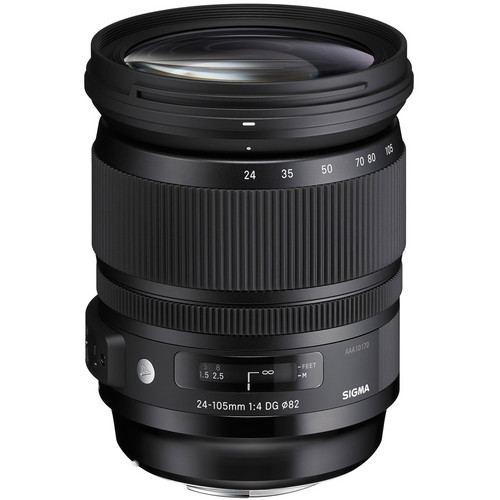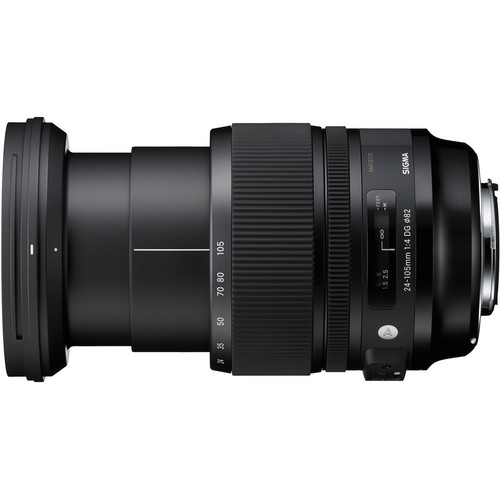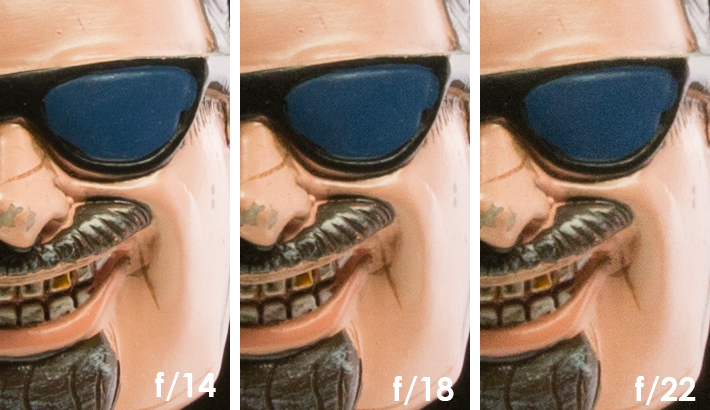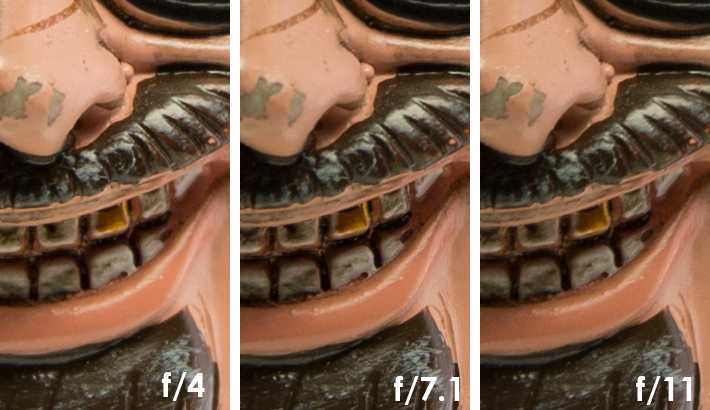I don’t know about you guys, but when Sigma announced the 24-105mm f/4 lens last year, I got very excited. The Canon 24-105mm f/4 was one of my favorite video lenses early on. It’s an extremely versatile focal length that, besides the slow f/4 constant aperture, was largely pretty usable in nearly any environment. Sadly, the lens was only good for video because it just wasn’t very sharp. That’s why Sigma’s attempt got me so jazzed. Based on prior experience with their Art line, I had high expectations for Sigma's new zoom lens.
Like nearly all of the lenses Sigma has put out over the past two years the build quality of the 24-105mm is outstanding (I say nearly because the only one to fall short in this category was the consumer-minded 17-70mm released in 2013), It has great weight to it without being too heavy, is built of metal on all exterior parts not covered in a rubber grip, and feels solid and sturdy in the hand. This is unlike what you might have come to expect out of the Canon 24-105mm f/4, though the Canon version is significantly lighter due to a prevalence of plastic parts. Unlike the Canon lens, however, the telescoping parts do not fall out of place when you hold it vertically. The Canon does that all the time, and it contributes to my dissatisfaction with the build quality.


I wanted to release a lot of footage taken with the 24-105mm, but the content of that video is still under embargo and I don't know when that embargo will be lifted. So you'll have to settle for this screen shot taken with the lens on a Canon 70D and believe me when I say this lens shines in video:
The focus ring is oddly placed behind the zoom ring, a choice that is now the second time Sigma has done this on a zoom lens (the first was on the 120-300mm Sports lens). I don’t like this decision, and neither do most of the people I have spoken to about this matter. The “correct” way, or at least the more established way, would be to have the focus ring exist closer to the front of the lens, with the zoom ring behind closer to the body. I’m uncertain as to why Sigma has swapped them on their last two zoom lenses, but it better not just be to be different. When shooting you will often be slowed down a bit because you forgot where the zoom ring was, which can be annoying. This happened frequently to me when shooting video.
If you rarely use manual focus, the autofocus on this lens is amazing. Silent, fast and accurate, it continues to display Sigma’s recent run of amazing autofocus advancements. It’s one of the areas Sigma struggled historically, but is completely a non-issue in recent years. The autofocus is so good, that autofocus tracking using the 70D dual pixel sensor went almost as well as when I use STM lenses (this is a huge compliment).
A major complaint of the Canon 24-105mm f/4 was the edge sharpness. Let’s be honest, it’s just bad even at what are normally considered rock-solid, sweet spot apertures of f/5.6 through f/8. So the biggest point for me to look at when testing this lens is if Sigma did a better job in this area.
The short answer? Yes. Much, much better job. Edge to edge sharpness is not perfect, but is more than acceptable especially compared to the alternative. The below is a sample taken at f/8, approximately 35mm zoom on a 5D Mark III, lower left hand corner of the frame at 100%:
If you look at that image above at 100% (which does require clicking), you don’t even have to squint. The difference is obvious. The leaves are more distinct, the edges are far less muddy and even the colors seem brighter. Though it’s not drop-dead amazing by any means on Sigma’s part, they make vast improvements over the previous standard. This is to be commended: we went from almost unusable, to a few levels beyond acceptable.
Center sharpness on the Sigma is shockingly consistent. Normally I expect to see a falloff of quality by a largely measureable amount at some point, but at all focal lengths and all apertures, the Sigma 24-105mm f/4 is very consistent. The weak point of this lens, as expected, is wide at 24mm. Though it is still sharp, the performance is not as good at 35mm and past. Take a look at 100% crop samples below, taken at 24mm:


The next batch of samples I shot at 51mm, and you can see the lens is getting into its groove and hitting a sweet spot. Much of the image degradation you see is caused by ISO, and the sharpness of the image and the overall quality is consistent:


Because zooming into an area at 105mm at 100% does not really show you much on this particular image sample, I went ahead and made all the samples available at 100% that I took here. This is where the lens shines. At 105mm, images are reliably crisp through the aperture range (click any of the below for the full resolution; listed in order: f/4, f/7.1, f/11, f/14, f/18, f/22).

Chromatic aberration is well controlled in this lens, appearing only at the wider zoom ranges. However at those wider zoom ranges it will appear even as far closed down as f/8. If we zoom out of the sample from the edge sharpness test, we can see some very minor purple fringing appearing on the edges of the highly reflective sign. This is easily removed in post or ignored altogether, but it would have been nice to not have to worry about it. That said, I understand the complications involved with a lens like this and I don’t hold it against Sigma. Canon’s 24-105 also exhibits nearly identical fringing.
It should also be noted that the center of focus on both the Sigma and the Canon above is indistinguishable. It's only on the edges that we see a big difference.
In studio, this lens worked wonderfully. I generally shoot headshots past f/4 anyway, so the limitation of the lens’ speed was a non-issue. At f/7.1, the lens captured a beautifully sharp image (click to view larger):
At 100% (click for full):
What I liked:
Sharpness
Build quality
Versatility
Reliable autofocus
Optical stabilization
Price
What could use improvement:
Layout of focus ring and zoom ring is backwards
f/4 is limiting for many event shooters
Minor chromatic aberration issues at wider focal lengths
Sturdiness comes at the cost of weight (heavy)
For what the Sigma 24-105mm f/4 is and who it is for, it is a fantastic lens. It’s easily better than the Canon L series lens, for $300 less. Though Canon is due for a refresh, for now it’s pales in comparison to what Sigma has been able to achieve. If given the choice, the Sigma brings to the table everything the Canon offers, but better. It is heavier than the Canon, but that’s the price of a full metal body.
Dark spaces are a trouble for this lens, as it’s not particularly fast at f/4 and of course we generally like to see a lens that features interior zooming. It’s not a do-everything lens like a 24-70mm f/2.8 tends to be, but I don’t know if it was ever meant to be. It’s a specialty lens that excels in controlled light situations for both stills and video purposes. It’s one more lens that Sigma has produced that proves they’ve changed their ways and is now capable of making reliable glass for professionals everywhere.
Sigma’s 24-105mm f/4 OS HSM is available for $899 for Canon, Sigma, Sony and Nikon mounts.
Test images were shot on a mix of the Canon 5D Mark III and Canon 70D.
Special thanks to Mike Kelley for his help in this review.


















The Sigma 70-200 OS HSM also has the reversed zoom/focus rings. Layout takes some getting used to but it isn't a problem after using the lens for a while.
This is true on both accounts (although I was specifically pointing only a their new lenses, and the 70-200 is not part of their "Global Vision").
I'm actually really happy you point that out, as it's a deal breaker for me. I've tried to get used to it (Nikon lenses are the same way, not to mention their body/lens caps, etc). For me, my body is used to turning the lens one way to go in, another to zoom out. It means the difference between getting or missing the shot sometimes.
You mention that the zoom isn't internal, but does the end element turn when zooming - or focusing? f4 is perfectly fine for landscape shots, but those little points may matter more than non internal zoom for people thinking of this as their travel glass.
Great question! No, the front element does not turn. So that's good.
As far as CA is concerned, my experiences with the Canon is that it exhibits it at both ends of the zoom scale. Only in the middle does work really well. In the studio I freelance in they use that lens a lot, and I've learned to spot that lens at any res clear across the internet because of it's CA. It's otherwise a good lens, save for your additional gripes about it.
I hope that I just tried a bad copy, but my results were much different. I work at a major Canadian retailer and have had the opportunity to extensively test this lens out on a 5DMk3. I found it softer than the Canon at all focal lengths and apertures. I REALLY wanted the Sigma to out perform the Canon in every way, I am a big Sigma fan, but it just didn't compare. Again, it could be a bad copy, so I will test another when I get a chance.
That's a huge disappointment, though it seems all manufacturers have a hard time making every lens they produce all perfect. Sigma certainly has done a better job of reducing the number of duds over the past two years, but it does still happen.
I agree 100%
Nice comparison. also if you could please share whether the pictures of the Sigma / Canon are straight out of the camera or color corrected or edited a bit?
As the pictures of the Sigma look much better/ sharper and seem to have better contrast when compared to the ones from the Canon side by Side (picture enclosed)
They are both SOOC.
Thanks for the clarification Jaron. Looks like Sigma have really hit a home run with this one.
Something worth noting: The Canon is weather-sealed and thats a huge deal for someone like me who sometimes gets stuck on cliff faces with the entire camera banging against rock. I live in Southeast Alaska and it rains 14 feet in my hometown. I have put the Canon 24-105 through hell. I look forward to owning the 24-70 f4 for its superior sharpness with the image stabilization and weather seal! I wish the sigma was sealed so bad!
It's maybe less worth noting since the Sigma 24-105 is weather-sealed as well.
It's worth noting that your 'maybe less worth noting,' statement is incorrect. Unless I'm wrong, and also DP Review, B&H's sales page, and Sigma's own website - are also wrong. Show me the weather seal promise! If we're all wrong I'll be thrilled!
Oops. OK, you're right. Sorry!
You must live in Catch A Chicken (as the radio ads say). It literally does rain 14 feet a year there.....
Nice Marcus Bobblehead!
Awesome that you recognized it! Thanks for noticing, fellow Vault Hunter.
I got my first full frame (D610) and the same lens two weeks ago. That Marcus bobblehead is the first thing I tested my lens with!
After two copies of the Canon version I sprung for the Sigma and couldn't be happier. Weather sealed doesn't create better IQ and corner sharpness. I own mostly Canon L glass but after the S 35 1.4 and this lens I will not hesitate to look elsewhere any longer.
I have this lense since a few days and it's awesome on my Canon 6D.
Just a note on the reverse AF/Zoom ring. This is also the case for the 70-200 f/2.8 from Sigma and it has a valid reason: It allows you do hold the lense more stable when you are zooming - especially in the case of the extending front lense of the 24-105. As I rarely use manual focus when holding the lense by hand I actually like this layout.
Now I am waiting for Adobe to release a lense profile for Lightroom for the Sigma 24-105.
I have a couple of things to note about your review of the lens. In regards to the flip/flop on the zoom/focus rings, Nikon did the same on their newest 24-120 f/4. It's a trend I think you'll be seeing more of as the focus ring is obviously less used these days.
As far is interior zooming goes, the Nikon 24-70 f/2.8 is not interior zooming either. The large hood hides the extension of the lens as it zooms. From what I can see the Canon 24-70 f/2.8L II also extends and the hood goes with along for the ride. There are very few normal zooms with complete interior zooms that I'm aware of except the 18-35mm f/1.8. In any case with a range as wide as 24-105 mm there's no way Sigma could have made it internal zooming as it would be twice the size of what is already a quite sizable lens.
You also claim a few times that the Sigma has a metal body, but it doesn't. The body is made from Sigma's new Thermally Composite Material (some sort of super polycarbonate I guess).
I just got my Nikon copy from Sigma and so far it's a great lens as you've noticed. I sold my Nikon 24-70 f/2.8 for almost as much as I bought it for because with the low-light capabilities of today's cameras I don't need f/2.8 like I did before. Now I can carry one camera and one lens when shooting music festivals instead of lugging around two cameras and two heavy f/2.8 zooms.
Sony makes a 18-105 F4 that is interior zooming. It is APSC only though.
Amazing review
Never owned Sigma lenses but this one sounds promising. Do I need to buy Sigma-USB-dock aswell? Does it fit for all Sigma lenses?
The dock fits them all, but it's not necessarily needed. I love my Sigma 35 "Art" but I don't have the dock.
Thanks! It is complicated. Sigma looks good but then canon is L with weather sealing. However, canon has more "monday pieces" on this line and many 24-105 owner has complained soft edges or bad focusing.
What's the image stabilisation like (I.e. How loud is it?). I use the Canon 24-105 mainly for video and it's IS is very loud, which is a problem if your trying to use something like a Rode VideoMic.
Also what is this lens like for Focus Breathing? Any issues that would make it tough for video?
Essentially my question boils down to. Is it worth selling my Canon and buying the Sigma?
Thanks for the info!
Do you have to fine tune this lens (USB Doc)
Hello Jon,
Yes, all Sigma lenses are sealed for dirt and moisture but we do not use an air check valve to make them totally weather proof, neither does any other manufacturer.
Sincerely,
Paul Pizzano
SIGMA Corporation of America l 15 Fleetwood Ct, Ronkonkoma, NY 11779
www.sigmaphoto.com
Phone: 631-585-1144 l Fax: 631-585-1895